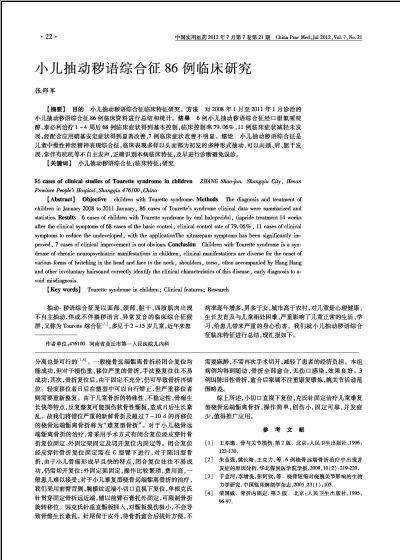小儿抽动秽语综合征86例临床研究(1)
 |
| 第1页 |
参见附件。
【摘要】目的 小儿抽动秽语综合征临床特征研究。 方法 对2008年1月至2011年1月诊治的小儿抽动秽语综合征86例临床资料进行总结和统计。 结果 6例小儿抽动秽语综合征经口服氟哌啶醇、泰必利治疗1~4 周后68例临床症状得到基本控制,临床控制率79.06%,11例临床症状减轻未发展,经配合应用硝基安定症状得到显著改善,7例临床症状改善不明显。 结论 小儿抽动秽语综合征是儿童中慢性神经精神表现综合征,临床表现多样以头面部为初发的多种形式抽动、可以向颈、肩、躯干发展,常伴有吭吭等不自主发声,正确识别本病临床特征,及早进行诊断避免误诊。
【关键词】
小儿抽动秽语综合征;临床特征;研究
86 cases of clinical studies of Tourette syndrome in children ZHANG Shao-jun. Shangqiu City, Henan Province Peoples Hospital,Shangqiu 476100,China
【Abstract】 Objective children with Tourette syndrome. Methods The diagnosis and treatment of children in January 2008 to 2011 January, 86 cases of Tourettes syndrome clinical data were summarized and statistics. Results 6 cases of children with Tourette syndrome by oral haloperidol, tiapride treatment 14 weeks after the clinical symptoms of 68 cases of the basic control, clinical control rate of 79.06%, 11 cases of clinical symptoms to reduce the undeveloped, with the applicationThe nitrazepam symptoms has been significantly improved, 7 cases of clinical improvement is not obvious. Conclusion Children with Tourette syndrome is a syndrome of chronic neuropsychiatric manifestations in children, clinical manifestations are diverse for the onset of various forms of twitching in the head and face to the neck, shoulders, torso, often accompanied by Hang Hang and other involuntary hairsound correctly identify the clinical characteristics of this disease, early diagnosis to avoid misdiagnosis.
【Key words】 Tourette syndrome in children; Clinical features; Research
抽动-秽语综合征是以面部、颈部、躯干、四肢肌肉出现不自主抽动,伴或不伴猥秽语言、异常发音的临床综合征候群, 又称为Tourette 综合征[1],多见于2~15岁儿童,近年来患病率逐年增多,男多于女,城市高于农村,对儿童是心理健康、生长发育及与儿童相处困难,严重影响了儿童正常的生活、学习,给患儿带来严重的身心伤害 ......
您现在查看是摘要介绍页,详见PDF附件(2505kb)。